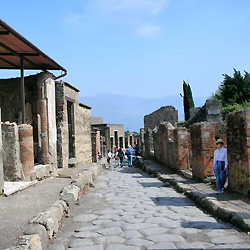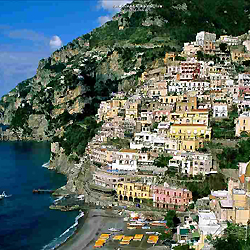Classic Italy tours
Venice, Como and the lakes | Cremona, Mantova, the Alps, Ortisei, Val Gardena | Pisa, Assisi, Siena, Florence, S. Gimignano | The Amalfi Coast and Isle of Capri | The Magical South and Sicily
The Amalfi Coast and the Isle of Capri
Tour suggested of 3 days and 2 nights starting from Rome, with the visit of Naples-Pompei, Sorrento, the Isle of Capri, the Amalfi Coast and Ravello, the service is driver/guided and is individually personalized.
| 1st Day: Naples- Pompei and Sorrento. Inhabited since ancient times, the first traces of a fully established human settlement date back to the seventh century B.C, when Pompei was used as a strategic commercial center by the Etruscan and Greek populations who chose the location for its opening on to the sea. The world wide fame of Pompei is, without the shadow of a doubt, linked to the eruption of the Vesuvius of August 29th of 79 A.D. which completely buried the city and the neighbouring towns of Herculaneum and Stabia. The hidden town was discovered by pure chance in 1594 by the Architect Domencio Fontana during the making of a trench. Excavations were initiated in 1748 by Carlo di Borbone whilst in the more recent past digs were supervised by Amedeo Maiuri in 1924 and by De Franciscis for those of 1961 which resulted in the uncovering of three fifths of the entire city. To visit whilst in Pompei, in addition to the archaeological site: the Amphitheatre, the House of Vettii, the House of Faun, the House of the Silver Wedding, the House of Menander, the Sanctuary of Pompei, the Basilica, the Museum of the Papal Sanctuary of Pompei, the Vesuvian Museum G.B. Alfano, the Temple of Apollo and the Villa of the Mysteries. Drive to Sorrento and overnight stay. |
 |
| 2nd Day: The Isle of Capri (Note: for the embark weather permit). From Sorrento we will embark to Capri. In the Gulf of Naples just off the end of the Sorrentine Peninsula, Capri is a veritable treasure trove bursting with natural beauty, with its stunning panoramas and dramatically beautiful coastline. Numerous symbols of the force of nature can be found here, such as the Faraglioni stacks, the Natural Arch, Monte Solaro and the celebrated Grotta Azzurra. Culture and history have intermingled on the island since the times of the emperors Augustus and Tiberius who built their Imperial residences here. To visit: Villa Jovis, Villa Damecuta, the sixteenth century Charterhouse of San Giacomo, the Church of Santo Stefano, Villa San Michele, built by the Swedish physician and writer, Axel Munthe, the Punta Carena, the second largest lighthouse in Italy, the Church of Santa Sofia, the Church of San Michele, the island's natural history Museum Centro Caprense "Ignazio Cerio". Not to be missed, of course, a few moments relaxation in the legendary Piazzetta, the fashionable square alternatively known as the "world's sitting room", and the walk along via Camerelle with its exclusive boutiques displaying the most fashionable designer labels. |
 |
| 3rd Day: Positano, Ravello and Amalfi. Positano position is unique: stacked vertically on the slopes of the Lattari mountains. Sheltered by mounts Comune, Santa Maria a Castello, Sant'Angelo dei Pizzi, Paipo, Canocchia and Campo dei Galli, Positano has an enviably mild climate which makes it a perfect seaside resort. There are panoramic views across the water towards the islets of Li Galli, known also as the "Sirenuse". It was on these three islets, the Gallo Lungo, Castellucco and the Rotonda, that, according to legend, the Sirens lived. Immersed in a spectacular landscape; Positano is not only an International tourist destination but also an important center for fashion design. Indeed, one of the town's major attractions is its vast array of boutiques, lining the narrow lanes and alleyways with their displays of colourful garments, typical of the town. To visit: the prehistoric caves, the Li Galli islands, the Roman Villas and underwater archaeological remains. During the summer season visitors can attend events such as the Festivals held at Montepertuso and Positano, and the International Art of Dance Awards. |
 |
| Ravello. Between the Valley del Dragone and the Valley della Regina, up a supremely panoramic narrow road, which twists up from the coast towards the mountains, one finds Ravello. Its dominating position on the hill top offers the tourist a spectacular view over the whole of the Amalfi Coast. The tranquillity of the town greatly appealed to poets and writers and international jet set. The wealth of art works in Ravello is preserved in numerous ecclesiastical buildings such as the Cathedral of St Pantaleone, Patron saint of the town, a building which is striking because of its marble work; the adjacent bell tower, the Church of St Martino, the Church of St Angelo and the Church of St Giovanni del Toro. The heart of Ravello is the Piazza Vescovado, with the Castle ruins, the Cathedral and Palazzo Rufolo. Villa Rufolo should not be missed, a building which is home to much of the art of Ravello and surrounded by splendid gardens, where numerous musical and cultural events are held. Villa Cimbrone is also well worth a visit. |
 |
| Amalfi. Legend has it that Hercules fell in love with a nymph called Amalfi, a love which was cruelly ended by her death. The nymph was then buried in this, the most beautiful place in the world, and the city which was built here was named after her. It is not by chance that Amalfi, an ancient maritime Republic, is the heart of this stretch of coast, the famous Amalfi Coast, an International tourist destination, attracting those lured by its uniquely colored sea. The town hosts many traditional celebrations and events, including the descent of the comet from Monte Tabor, the Festa of St. Giuseppe, the Festa of St. Antonio, the historic sailing regatta contested by the four maritime republics, the lemon fair, St.Andrea patron saint of Amalfi, the underwater procession to the Grotta dello Smeraldo held at Christmas, the firework display of New Year's Eve and the traditional Via Crucis. To see: the Church of St Antonio, the Convent of St Francesco, the Paper Museum, the Chapel of St. Giuseppe del Castrista and the sumptuous Amalfi Cathedral. The most important of the town's craft traditions is that of paper making, which began in the 1700's. Drive back to Rome. |
 |